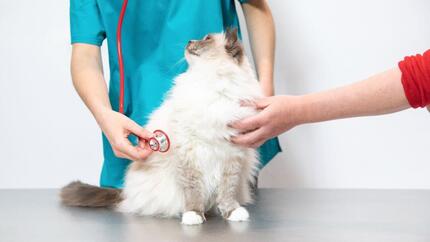Cystitis in Cats: Symptoms, Causes, and Treatment



If you’ve noticed that your cat is having problems urinating, it may be down to a common condition called cystitis. Specifically, cystitis in cats is caused by inflammation in the urinary bladder which affects their ability to pass urine and can often be quite painful and uncomfortable for your furry friend.
The condition is also known as idiopathic cystitis in cats, where the term ‘idiopathic’ means that there is no clear understanding of its cause. Unfortunately, this is both a common and complex condition and, because symptoms can be medical and/or behavioural, you won’t always know exactly what’s triggered it.
Although both male and female cats can get cystitis, tom cats have a narrower and longer urethra which can become blocked by leaked proteins and blood. This is a life-threatening complication which means the cat physically cannot urinate.
What causes idiopathic cystitis in cats?
Stress, which can be manifested in many forms, is the most common trigger of feline idiopathic cystitis. As your cat experiences anxiety, their bladder’s protective layer often becomes patchy and stops doing its job of making sure that the bladder is protected against the harsh chemical components found in urine.
No matter how calm and unbothered your cat may seem, there’s always some level of stress in your pet which you might not even be able to detect because they’re notoriously good at hiding it. In general, changes are common triggers of stress. This can include being by themselves for longer periods, having to share their space with other pets, and interactions with strangers. Even moving furniture around the home might cause abnormal levels of stress in your cat.
Genetics can also play a key role in your pet’s chances of being diagnosed with feline idiopathic cystitis. This is something you have no control over and so it’s very difficult to prevent. All you can do is be on the lookout and spot the signs early on to be able to provide appropriate treatment.
Signs of cystitis in cats
The signs of feline idiopathic cystitis can be both behavioural and medical, a few of the most common cystitis in cats symptoms are listed below.
- Repeatedly going into and out of their litter tray.
- Urinating in unusual places around the house.
- Straining to go to the toilet.
- Pain when urinating (usually characterised by crying out when going to the toilet).
- Licking their genital area a lot more than usual.
- Blood in their urine – it may appear pink or dark.
- Producing little or no urine after straining.
- Loss of bladder control (although this is rare).
- Lack of appetite.
- Lethargy and reduced interest in regular activities.
If your cat displays any of the symptoms listed above, seek veterinary help straight away. Cystitis in cats can be a very serious and life-threatening condition so it’s imperative that it’s caught early.
Diagnosing feline idiopathic cystitis
Once your vet has run a few tests to rule out other causes like bladder stones, cancerous masses, or infections, they’re most likely to diagnose your cat’s condition as feline idiopathic cystitis. They may still do blood tests, just to make sure your cat doesn’t have any underlying kidney problems or other issues, and they might collect a urine sample. If further confirmation is needed, your vet may want to take x-rays and use an ultrasound to get a clearer picture of your cat’s bladder and urethra.
Treating cystitis in cats
Feline idiopathic cystitis can be tricky to treat and takes lots of patience and time and may even require help from a feline veterinary specialist or behaviourist. It’s a condition that can also go away by itself but, considering the discomfort and pain it can cause your cat, it’s best to seek treatment as soon as you spot the first symptoms.
The good news is that with veterinary help, many cats with urinary problems go on to have normal and happy lives. Some of the most common treatment options for cystitis and urinary issues in cats are listed below.
Pain relief
Cystitis in cats is often quite uncomfortable and, because pain can also cause the urethra to narrow further, pain relief is often prescribed.
Medication
Some drugs can be used to relax the urethra in male cats to try to prevent or treat blockages. Extra support, like medication supplements or pheromone therapy may also be recommended by your vet to help improve your cat’s bladder wall lining.
Stress reduction
Stress is known to play a part in feline idiopathic cystitis so speak to your vet about anything you think could be causing your cat stress and how it can be avoided. Your vet might recommend speaking to a veterinary behaviourist or suggest synthetic pheromone treatments to help with any anxiety your cat might be feeling.
There are also a few things you can do to minimise your cat’s stress as far as possible.
- Provide an extra food bowl, water bowl, and litter tray for every pet in the house.
- Routine is key. Be consistent with their mealtimes and minimise interactions with strangers as much as you can.
- Keep their bowls clean and separate from their litter trays. Also, cats prefer litter that is clumping and unscented and their litter trays should always be big enough.
- Avoid exposing them to loud noises like a vacuum cleaner or washing machine.
- Provide a ‘kitty condo’ which can give them plenty of stimulation and entertainment options.
- Consider raised sleeping platforms for cats to help reduce their stress levels.
- Allow your pet to go outside whenever they want.
Reduction in the concentration of the urine
It’s extremely important that your cat eats a good pH-balanced diet and drinks plenty of water to avoid any possible cystitis in cats symptoms. If your cat currently eats a dry food diet, try switching them to wet food. If they’re already eating wet food, add a little water or give them ‘soups’ of tuna or chicken in plenty of water (without salt).
Increased water intake
Encourage your cat to drink more water by giving them plenty of sources of water—from cat water fountains to wide-brimmed bowls—in several locations, both inside and outside the house. Cats don’t usually have a strong drive to drink water so try flavouring it with unsalted chicken broth or tuna juice to make it more appealing. In addition, fill their water bowls right to the top so they don’t have to put their head deep into the bowl to drink. Also make sure to refresh their water often and use filtered or distilled water. If you’re wondering how much water your cat should be drinking, read our guide on this topic.
Whatever the cause of the feline idiopathic cystitis, your vet should be able to quickly prescribe a treatment to get your pet back to their usual vibrant, happy selves again so that you can make the best of your time together.
Explore our cat brands:
More articles by PPVD











